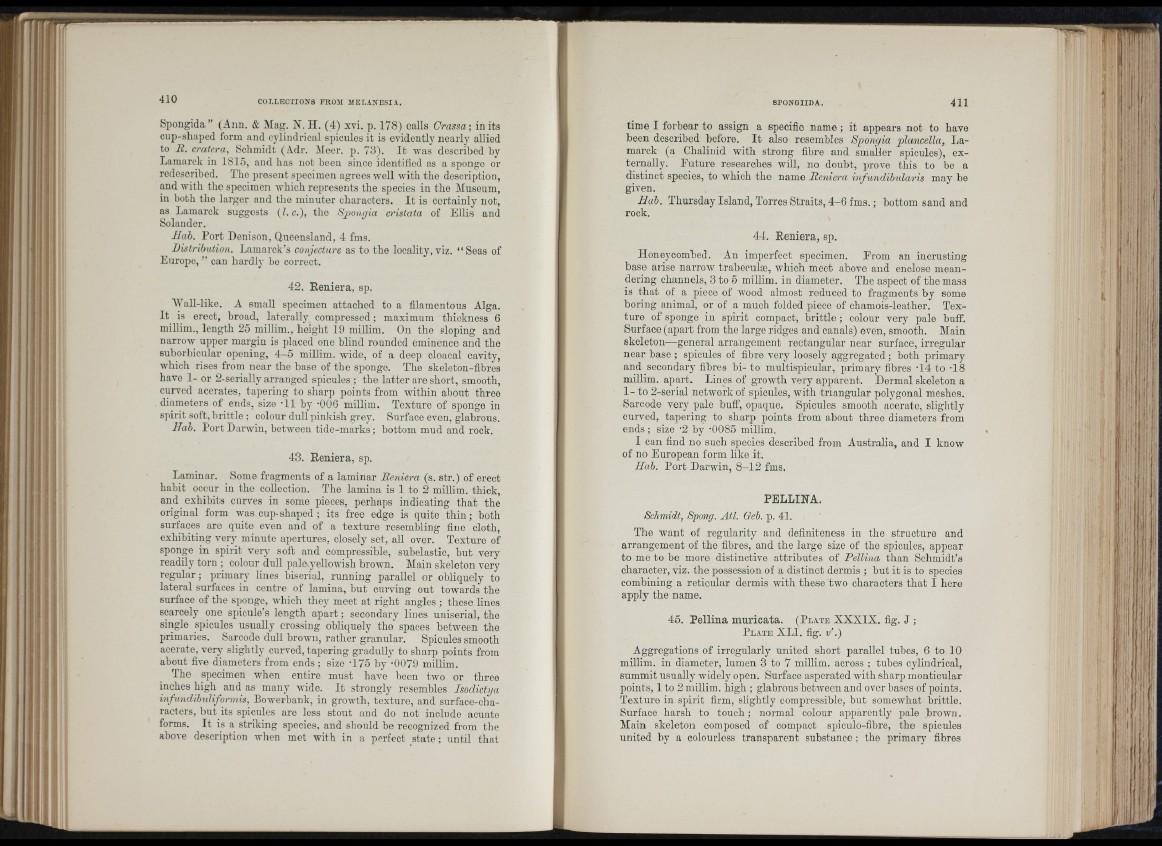
Spongida” (Ann. & Mag. N. H. (4) xvi. p. 178) calls Crassa; in its
cnp-shaped form and cylindrical spicules it is evidently nearly allied
to 11. cratera, Schmidt (Adr. Meer. p. 73). I t was described by
Lamarck in 1815, and has not been since identified as a sponge or
redescribed. Tho present specimen agrees well with the description,
and with the specimen which represents the species in the Museum,
in both tho larger and the minuter characters. I t is certainly not,
as Lamarck suggests (I. c.), the Sqiongia cristata of Ellis and
Solauder.
Uab. Port Denison, Queensland, 4 fms.
Distribution. Lamarck’s conjecture as to the locality, viz. “ Seas of
Europe, ” can hardly be correct.
42. Reniera, sp.
Wall-like. A small specimen attached to a filamentous Alga.
I t is erect, broad, laterally compressed; maximum thickness 6
millim., length 25 millim., height 19 millim. On the sloping and
narrow upper margin is placed one blind rounded eminence and the
suhorbicular opening, 4 -5 millim. wide, of a deep cloacal cavity,
which rises from near the base of the sponge. Tho skeleton-fibres
have 1- or 2-serially arranged spicules ; the latter are short, smooth,
curved acerates, tapering to sharp points from within about three
diameters of ends, size ’11 by '006 millim. Texture of sponge in
sjfirit soft, brittle ; colour dull pinldsh grey. Surface even, glabrous.
Hah. Port Darwin, between tid e-mark s; bottom mud and rock.
43. Reniera, sp.
Laminar. Some fragments of a laminar Reniera (s. str.) of erect
habit occur in the collection. The lamina is 1 to 2 millim. thick,
and exhibits curves in some pieces, perhaps indicating th a t the
original form was cup-shaped; its free edge is quite th in ; both
surfaces are quite even and of a texture resembling fine cloth,
exhibiting very minute apertures, closely set, all over. Texture of
sponge iu spirit very soft and compressible, subelastic, hut very
readily torn ; colour dull palo yellowish brown. Main skeleton very
reg u la r; primary lines biserial, running parallel or obliquely to
lateral surfaces in centre of lamina, but curving out towards the
surface of the sponge, which they meet at right angles ; these lines
scarcely one spicule’s length a p a r t; secondary lines nuiserial, the
single spicules usually crossing obliquely the spaces between the
primaries. Sarcode dull brown, rather granular. Spicules smooth
acerate, very slightly curved, tapering gradully to sharp points from
about five diameters from euds; size -175 by -0079 millim.
The specimen when entire must have been two or three
inches high and as many wide. I t strongly resembles Isodictya
infundibuliformis, Bowerbank, in growth, texture, and surface-cha-
racters, but its spicules are less stout and do not include acuate
forms. I t is a striking species, and should be recognized from the
above description when met with in a perfect state ; until that
time I forbear to assign a specific name ; it appears not to have
been described before. I t also resembles Spongia plancella, Lamarck
(a Chalinid with strong fibre and smaller spicules), externally.
Enture researches will, no doubt, prove this to be a
distinct species, to which tho name Reniera infundibularis may be
given.
Hab. Thursday Island, Torres Straits, 4 -6 fms. ; bottom sand and
rock.
44. Reniera, sp.
Honeycombed. An imperfect specimen. Erom an incrusting
base arise narrow trabeeulæ, which meet above and enclose meandering
channels, 3 to 5 millim. in diameter. The aspect of the mass
is th at of a piece of ivood almost reduced to fragments by some
boring animal, or of a much folded piece of chamois-leather. Texture
of sponge iu spirit compact, brittle ; colour very pale huff.
Surface (apart from the large ridges and canals) even, smooth. Main
skeleton:—general arrangement rectangular near surface, irregular
near base ; spicules of fibre very loosely aggregated ; both primary
and secondary fibres bi- to multispicular, primary fibres -14 to -18
millim. apart. Lines of growth very apparent. Dermal skeleton a
1- to 2-serial network of spicules, with triangular polygonal meshes.
Sarcode very pale buff, opaque. Spicules smooth acerate, slightly
curved, tapering to sharji points from about three diameters from
ends ; size -2 by -0085 millim.
I can find no such species described from Australia, aud I kuow
of uo European form like it.
Ilah. Port Darwin, 8 -1 2 fms.
PELLINA.
Schmidt, Spong. Atl. Geh. p. 41.
The want of regularity and definiteness iu the structure and
arrangement of the fibres, and the large size of the spicules, appear
to me to be more distinctive attributes of Pellina than Schmidt’s
character, viz. the possession of a distinct dermis ; but it is to species
combining a reticular dermis with these two characters th at I here
apply the name.
45. Pellina muricata. ( P l a t e XXXIX. fig. J ;
P l a t e XLI. fig. v'.)
Aggregations of irregularly united short parallel tubes, 6 to 10
millim. in diameter, lumen 3 to 7 millim. across ; tubes cylindrical,
summit usually widely open. Surface asperated with sharp monticular
points, 1 to 2 millim. high ; glabrous between and over bases of points.
Texture in spirit firm, slightly compressible, but somewhat brittle.
Surface harsh to touch ; normal colour apparently pale brown.
Main skeleton composed of compact spiculo-fibre, the spicules
united by a colourless transparent substance ; the primary fibres
■V; :
I I.
k:
'i': ! :